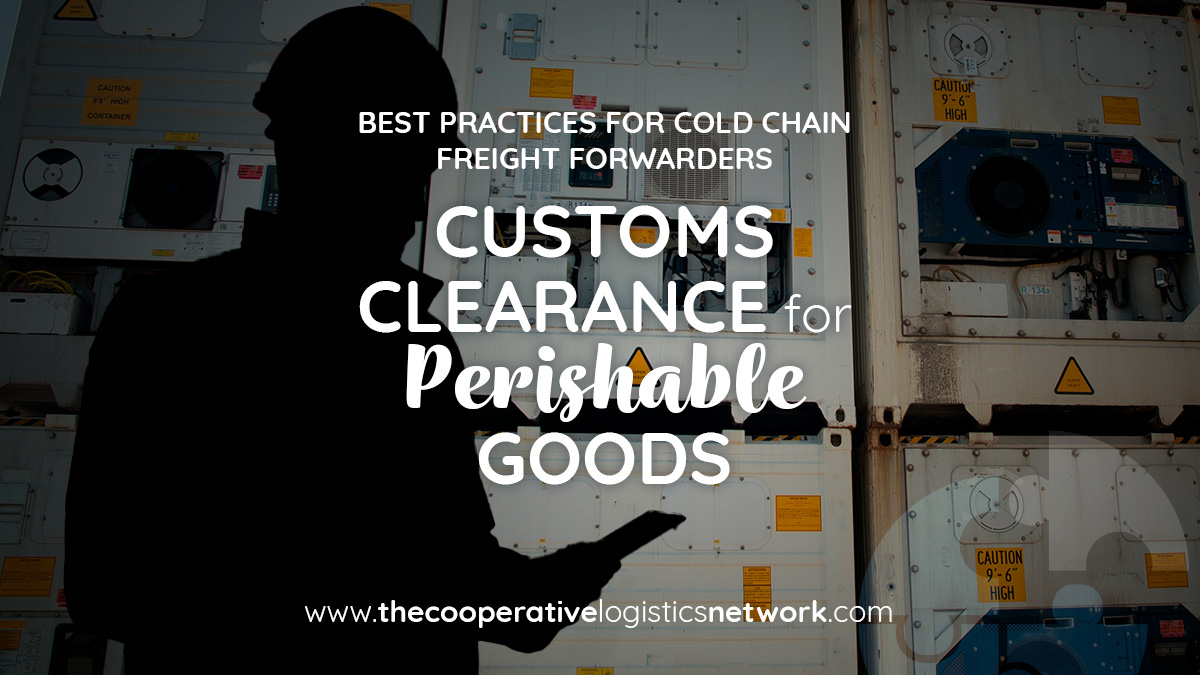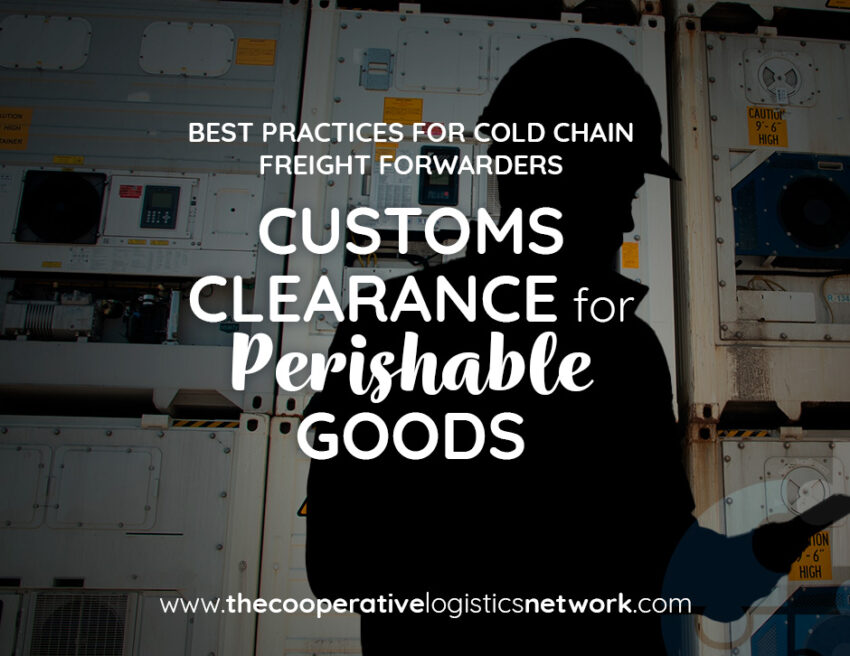Time is everything when it comes to transporting perishables. One missed connection or delay at customs can ruin an entire shipment of strawberries, seafood, or pharmaceuticals. For cold chain freight forwarders, the race against time doesn’t end at the loading dock — it continues at the customs checkpoint. Smooth and speedy customs clearance is a crucial link in the cold supply chain, where product integrity and shelf life depend on split-second coordination.
So how can cold chain freight forwarders navigate complex customs procedures without compromising temperature-sensitive goods? What regulations must they master, and which best practices ensure success? In this blog, we explore the critical customs clearance strategies every cold chain operator should follow to maintain compliance, speed, and cold chain integrity.

Why Customs Clearance is Critical for Cold Chain Freight Forwarders
Perishable goods — from fresh produce and dairy to vaccines and biologics — are highly sensitive to delays. Even a short disruption during customs clearance can result in temperature excursions, product spoilage, or contamination. For cold chain freight forwarders, customs isn’t just a compliance step — it’s a make-or-break moment for the cargo.
Unlike general cargo, perishables often require special handling, temperature documentation, expedited inspections, and coordination with multiple regulatory bodies (e.g., health, agriculture, or food safety authorities). A shipment of frozen shrimp, for instance, may need approvals from customs, port health authorities, and food safety regulators before release. This layered complexity makes customs clearance both a compliance and logistical challenge.
To succeed, cold chain freight forwarders must blend regulatory expertise with airtight operational planning.
Understanding the Regulatory Framework
The first step in efficient customs clearance is understanding the regulatory landscape. Rules for importing perishables differ based on product type and country of destination. Some of the key regulatory requirements include:
-
Sanitary and Phytosanitary (SPS) Certificates for meat, seafood, dairy, fruits, and vegetables
-
Health Certificates issued by exporting countries
-
Import Permits or Licenses for certain restricted food or pharmaceutical products
-
Certificates of Origin, especially for goods qualifying under trade agreements
-
Compliance with Codex Alimentarius or national food safety standards
Cold chain freight forwarders must ensure all documentation is accurate, complete, and submitted ahead of time to prevent customs delays. Regulatory missteps not only result in cargo detention but may also attract penalties or product destruction orders.
Additionally, the growing focus on food safety and pharmaceutical compliance (e.g., GDP or GxP standards) has increased the need for proper temperature logs, product traceability, and condition monitoring throughout customs transit.
Key Challenges in Clearing Perishable Shipments
One of the biggest obstacles in perishable logistics is the lack of coordination between customs and other inspection authorities. For example, a customs officer may be ready to release a shipment, but the agricultural or health inspector might not be available, leading to costly delays.
Another challenge is temperature integrity during inspections. If customs requires goods to be unpacked or inspected, this can expose perishables to ambient conditions unless refrigerated spaces are available. Delays at ports or airports can also lead to extended storage in less-than-ideal conditions.
Documentation issues are another common source of delays. Mistakes in HS codes, incorrect invoice values, missing health certificates, or misdeclared origins can trigger red flags and inspections. Since perishables are time-critical, even minor document errors can have major repercussions.
For cold chain freight forwarders, avoiding these pitfalls starts with solid preparation and proactive communication with customs brokers, airlines, shipping lines, and inspection agencies.
Best Practices for Cold Chain Freight Forwarders
1. Advance Documentation Preparation
Submitting accurate and complete documents well before cargo arrival is the most effective way to fast-track customs clearance. Ensure that invoices, packing lists, import permits, health/sanitary certificates, and temperature monitoring data are all submitted digitally when possible. Pre-clearance programs and electronic customs platforms can also help accelerate the process.
2. Work with Specialized Customs Brokers
Partnering with brokers who specialize in perishable cargo ensures a deeper understanding of product-specific regulations. Experienced brokers can advise on the correct HS codes, required documentation, and potential inspection risks, minimizing clearance issues. Cold chain freight forwarders should maintain open communication with brokers and provide real-time updates on shipping status, expected arrival times, and temperature tracking.
3. Use Smart Packaging and Temperature Loggers
Using advanced insulated packaging with built-in temperature sensors or data loggers allows you to demonstrate that goods remained within acceptable temperature ranges throughout transit. This can be critical during customs inspections or in the event of claims. Many customs authorities now accept digital data from IoT devices and smart tags, which can help expedite release and prove compliance with safety standards.
4. Choose Customs-Friendly Routes and Entry Points
Not all ports and airports are equally equipped to handle perishable goods. Cold chain freight forwarders should plan routes through terminals that have dedicated cold storage, 24/7 customs clearance, and trained inspection staff. These facilities reduce exposure to temperature changes and speed up cargo processing. Some forwarders even opt for customs-bonded cold storage facilities near the port to hold goods until clearance is complete, minimizing risk.
5. Establish Relationships with Border Agencies
A strong working relationship with local customs and inspection authorities can help smooth over last-minute issues. When officers are familiar with your processes and reliability, they’re more likely to support faster inspections or accept electronic documentation.
In some regions, trusted trader programs or Authorized Economic Operator (AEO) status can further reduce inspection frequency and clearance time.
Technology’s Role in Streamlining Customs for Perishables
Digital platforms are revolutionizing how customs clearance is handled. Blockchain-based supply chain records, for instance, can offer immutable documentation of a perishable product’s journey, improving transparency and compliance.
Digital trade documents, such as the electronic bill of lading (eB/L), enable quicker cargo release. Customs single window systems — already in use across much of Asia and Europe — allow for simultaneous submission of documents to customs, food safety, and health departments, avoiding redundant paperwork.
Cold chain freight forwarders who invest in tech-enabled visibility and automated compliance systems will be better positioned to meet evolving regulatory demands and client expectations.
The Cost of Customs Delays: A Perishable Reality
Delays in customs clearance aren’t just inconvenient — they’re expensive. Perishable cargo loses value with every hour of delay. Spoilage, rejections by buyers, airfreight surcharges, and additional storage fees can cost thousands of dollars per shipment. In some cases, delayed clearance can result in the complete loss of the cargo, impacting brand reputation and customer trust.
Cold chain freight forwarders must treat customs clearance with the same urgency and precision as temperature control itself. A break in either link can compromise the entire shipment.
Final Thoughts: Making Customs a Competitive Advantage
In the world of cold chain logistics, customs clearance is a pivotal stage where delays can derail even the best-planned supply chains. But with the right expertise, preparation, and technology, cold chain freight forwarders can transform customs clearance from a bottleneck into a competitive edge.
By mastering the documentation, partnering with the right brokers, investing in smart tracking, and working closely with inspection authorities, forwarders can offer clients not just delivery — but delivery with confidence, compliance, and cold chain integrity intact.
For those who handle perishable cargo, customs isn’t just the gateway to the market — it’s the gatekeeper of quality. And quality is what keeps clients coming back.


